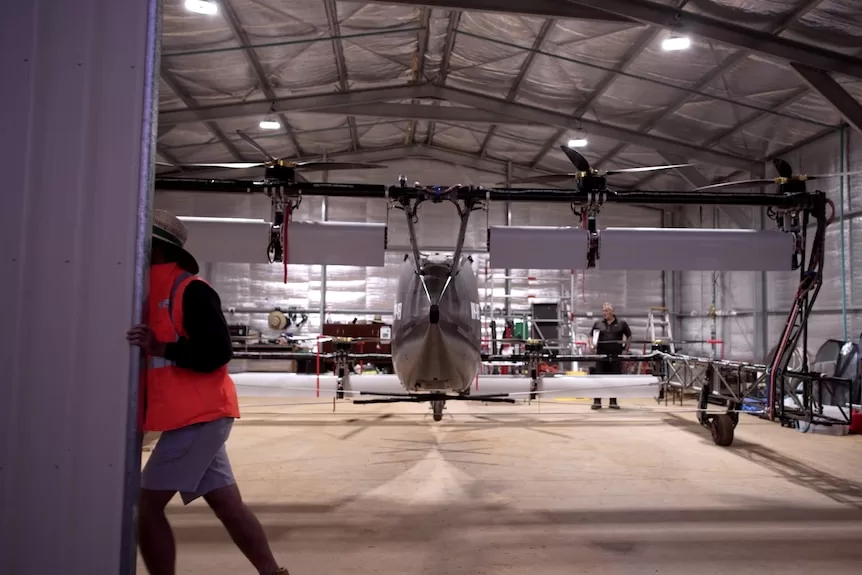- In short: Testing is underway for a hydrogen-powered electric aircraft developed by Australian startup, AMSL Aero.
- The company received its first commercial order from AirLink and could be flying regional passengers by 2027.
- What’s next? Hydrogen fuel cell technology is expected to feature in the federal government’s Aviation White Paper.
While the race to transform electric vehicles on land speeds up, it is a different story in the sky.
Battery technology is not yet able to power even the smallest aircraft beyond 200 kilometres, and in Australia, that is hardly worth the effort.
But an Australian aviation startup on a mission to decarbonise air travel is developing a battery that could power a small aircraft to travel 1,000 km using hydrogen, and it already has a customer.
AMSL Aero received the first commercial order for its Vertiia aircraft from Aviation Logistics, the company behind regional airline AirLink.
AirLink chief executive Matthew Kline said the purchase was key to meet industry plans to be net zero by 2050.
“Using hydrogen is a game-changer for us, we can get up to 1,000km flight distance and that’s what we need for the work we do,” he said.
The next decade of aviation policy will be outlined with the release of the federal government’s Aviation White Paper later this year.
Last year’s Green Paper indicated two areas of focus were net zero emissions and accessibility for regional and remote communities, both of which could be supported by aircraft known as Advanced Air Mobility (AAM) services.
Vertiia is the first Australian-made aircraft to apply for AAM-type certification through the Civil Aviation Safety Authority (CASA).
In a statement, CASA called it an exciting yet “daunting” task, considering Vertiia had features of both a helicopter and a fixed-wing aircraft.
“Nobody’s done this in Australia ever and in that sense, it will be breaking new ground,” said manager of aircraft certification, Klaus Schwerdtfeger.
Testing is already underway at an airstrip near Wellington, in central-west New South Wales, and if all regulatory approvals are met, operations could begin in 2027.
AirLink plans to initially rollout Vertiia for its freight and charter flight services, with a view of later introducing the hydrogen-powered aircraft for its scheduled service flying Dubbo, Walgett, Bourke and Lightning Ridge.
“At the moment, we fly out to Bourke and leave the aircraft out there all day before we fly back in the afternoon,” Mr Kline said.
“But because the running costs are so much lower, we could bring that aircraft back and do other flights or run there and back a few times in a day.”
Takes off like a helicopter, flies like a plane
As companies across the globe work to improve the fuel efficiency of existing planes, AMSL Aero co-founder Siobhan Lyndon said they chose instead to start from scratch.
“There are companies who are retrofitting fixed-wing aircraft and helicopters but this is a clean-sheet design,” she said.
Co-founder and chief engineer Andrew Moore took inspiration from another Australian inventor while developing the Vertiia’s box-wing design.
“It’s an evolution of the box kite which Lawrence Hargrave invented, and it’s one of the oldest, funnily enough,” he said.
Lawrence Hargrave was an Australian aeronautical pioneer who experimented with theories of flight to construct different flying machine models in the late 19th century.
“We actually did lots of configuration studies and just happened to come to the same conclusion that Hargrave did, the box-wing works really well.”
The Vertiia design uses eight motors pointed vertically for take-off and landing that rotate to a horizontal position when at cruising altitudes up to 10,000 feet, or 3,000 metres.
While other electric vertical take-off and landing aircraft (eVTOL) do exist, AMSL Aero hopes to be the first long-range eVTOL to market using hydrogen.
“Nearly all other eVTOL are focused on electric batteries which have a shorter range to serve the urban air mobility market like Manhattan, or that Silicon Valley-to-San Francisco route,” Ms Lyndon said.
“Those aircraft will have a 160km range to start with, but we see hydrogen as a game changer for us to allow that longer range of 1,000km non-stop.”
60 million drone flights annually by 2043
In October last year, researchers from Swinburne University of Technology completed the first flight of an uncrewed hydrogen fuel cell eVTOL drone in Australia.
By retrofitting existing drones with electric and hydrogen fuel cell systems, the Aerostructures Innovation Research (AIR) Hub team has been able to develop flight data for hydrogen-powered aircraft.
It is an area sorely lacking in data, according to AIR Hub director Adriano di Pietro.
“There is some work happening internationally, but it’s usually locked up in a proprietary sense,” Dr di Pietro said.
“The other reason we’re doing this work is to really drive the use case and demand, to help Aussie companies actually justify doing first development for aviation systems.”
AMSL Aero is also developing its own uncrewed aircraft after receiving a $3 million grant from the federal government’s Cooperative Research Centre program to build a remotely piloted version of Vertiia to be used for aerial firefighting.
“Being remotely piloted, you might use it in ways that are too risky for a pilot today,” Mr Moore said.
“It could potentially save people’s lives on the ground by getting to those situations where there’s a raging fire threatening people.”
In March, Airservices Australia announced plans to develop a digital air traffic management system after an analysis projected the growth of drone and uncrewed aircraft would reach 60 million annual flights by 2043.
“I think what is not talked about a lot is the fact that aviation underpins a lot of industry in Australia that most people aren’t aware of,” Dr di Pietro said.
“Most of the land area of Australia is serviced by aviation and certainly, there is a big government push at the moment to drive that forward.”
Get our local newsletter, delivered free each Friday
